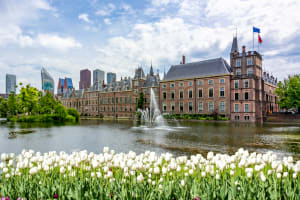
Panorama Mesdag is a museum located in The Hague, Netherlands. It is famous for its panoramic painting of the sea, dunes and fishing village of Scheveningen. The painting was created by Hendrik Willem Mesdag and a group of artists, and was completed in 1881. It is 14 meters high and 120 meters in circumference, and is displayed in a specially constructed circular building.
The painting is an example of a 19th-century panoramic art form that was popular in Europe, and it was created using a unique technique known as trompe-l'oeil, which means "deceive the eye" in French. The painting is designed to create the illusion of a real-life scene, with the viewer feeling as if they are standing in the middle of the village of Scheveningen, surrounded by the sea and the dunes.
In addition to the panoramic painting, the museum also features a collection of works by Hendrik Willem Mesdag and other 19th-century artists, as well as a display on the history of panoramic art. Visitors can learn about the techniques used to create these unique artworks, as well as the history and development of panoramic art in Europe.
Panorama Mesdag is a popular attraction for tourists visiting The Hague, and is considered to be one of the most important examples of 19th-century panoramic art in Europe.
Explore Near Panorama Mesdag
Discover 5 attractions, 5 cities, and 2 airports within 75km. Perfect for planning day trips, finding connecting flights, or discovering new destinations to explore during your visit.
Nearby Attractions & Places to Visit
5 destinations within 636m - 1.7km from your location





Nearby Cities Worth Exploring
5 destinations within 1.0km - 19.3km from your location
Airports Near Panorama Mesdag
2 destinations within 16.9km - 40.0km from your location
Cross-Border Adventures Near Panorama Mesdag
Discover cross-border adventures near Panorama Mesdag. Explore neighboring countries with similar attractions and extend your travel experience across borders.

